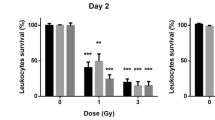Abstract
The γ-H2AX assay is a sensitive and reliable method to evaluate radiation-induced DNA double-strand breaks. The conventional γ-H2AX assay detects individual nuclear foci manually, but is labor-intensive and time-consuming, and hence unsuitable for high-throughput screening in cases of large-scale radiation accidents. We have developed a high-throughput γ-H2AX assay using imaging flow cytometry. This method comprises (1) sample preparation from small volumes of blood in the Matrix™ 96-tube format, (2) automated image acquisition of cells stained with immunofluorescence-labeled γ-H2AX using ImageStream®X, and (3) quantification of γ-H2AX levels and batch processing using the Image Data Exploration and Analysis Software (IDEAS®). This enables the rapid analysis of γ-H2AX levels in several thousand of cells from a small volume of blood with accurate and reliable quantitative measurements for γ-H2AX foci and mean fluorescence levels. This high-throughput γ-H2AX assay could be a useful tool not only for radiation biodosimetry in mass casualty events, but also for large-scale molecular epidemiological studies and individualized radiotherapy.
Access this chapter
Tax calculation will be finalised at checkout
Purchases are for personal use only
Similar content being viewed by others
References
Rothkamm K, Horn S (2009) Gamma-H2AX as protein biomarker for radiation exposure. Annali dell’Istituto superiore di sanita 45:265–271
Rogakou EP, Pilch DR, Orr AH, Ivanova VS, Bonner WM (1998) DNA double-stranded breaks induce histone H2AX phosphorylation on serine 139. J Biol Chem 273:5858–5868
Mah LJ, El-Osta A, Karagiannis TC (2010) gammaH2AX: a sensitive molecular marker of DNA damage and repair. Leukemia 24:679–686
Dickey JS, Redon CE, Nakamura AJ, Baird BJ, Sedelnikova OA, Bonner WM (2009) H2AX: functional roles and potential applications. Chromosoma 118:683–692
Moquet J, Barnard S, Staynova A, Lindholm C, Monteiro Gil O, Martins V, Rossler U, Vral A, Vandevoorde C, Wojewodzka M, Rothkamm K (2017) The second gamma-H2AX assay inter-comparison exercise carried out in the framework of the European biodosimetry network (RENEB). Int J Radiat Biol 93:58–64
Roch-Lefevre S, Mandina T, Voisin P, Gaetan G, Mesa JE, Valente M, Bonnesoeur P, Garcia O, Voisin P, Roy L (2010) Quantification of gamma-H2AX foci in human lymphocytes: a method for biological dosimetry after ionizing radiation exposure. Radiation Res 174:185–194
Horn S, Barnard S, Rothkamm K (2011) Gamma-H2AX-based dose estimation for whole and partial body radiation exposure. PLoS One 6:e25113
Moquet J, Barnard S, Rothkamm K (2014) Gamma-H2AX biodosimetry for use in large scale radiation incidents: comparison of a rapid ‘96 well lyse/fix’ protocol with a routine method. Peer J 2:e282
Rothkamm K, Lobrich M (2003) Evidence for a lack of DNA double-strand break repair in human cells exposed to very low x-ray doses. Proc Natl Acad Sci U S A 100:5057–5062
Muslimovic A, Ismail IH, Gao Y, Hammarsten O (2008) An optimized method for measurement of gamma-H2AX in blood mononuclear and cultured cells. Nat Protoc 3:1187–1193
Johansson P, Fasth A, Ek T, Hammarsten O (2017) Validation of a flow cytometry-based detection of gamma-H2AX, to measure DNA damage for clinical applications. Cytometry B Clin Cytom 92:534–540
Hamasaki K, Imai K, Nakachi K, Takahashi N, Kodama Y, Kusunoki Y (2007) Short-term culture and gammaH2AX flow cytometry determine differences in individual radiosensitivity in human peripheral T lymphocytes. Environ Mol Mutagen 48:38–47
Basiji DA, Ortyn WE, Liang L, Venkatachalam V, Morrissey P (2007) Cellular image analysis and imaging by flow cytometry. Clin Lab Med 27:653–670, viii
Basiji D, O’Gorman MR (2015) Imaging flow cytometry. J Immunol Methods 423:1–2
Basiji DA (2016) Principles of amnis imaging flow cytometry. Methods Mol Biol 1389:13–21
Lee Y, Wang Q, Shuryak I, Brenner DJ, Turner HC (2019) Development of a high-throughput gamma-H2AX assay based on imaging flow cytometry. Radiat Oncol 14:150
Ding D, Zhang Y, Wang J, Zhang X, Gao Y, Yin L, Li Q, Li J, Chen H (2016) Induction and inhibition of the pan-nuclear gamma-H2AX response in resting human peripheral blood lymphocytes after X-ray irradiation. Cell Death Discov 2:16011
Solier S, Pommier Y (2009) The apoptotic ring: a novel entity with phosphorylated histones H2AX and H2B and activated DNA damage response kinases. Cell Cycle 8:1853–1859
Turner HC, Shuryak I, Taveras M, Bertucci A, Perrier JR, Chen C, Elliston CD, Johnson GW, Smilenov LB, Amundson SA, Brenner DJ (2015) Effect of dose rate on residual gamma-H2AX levels and frequency of micronuclei in X-irradiated mouse lymphocytes. Radiat Res 183:315–324
Acknowledgements
This study was supported by a grant of the Korea Institute of Radiological and Medical Sciences, funded by Nuclear Safety and Security Commission of the Republic of Korea (50091-2023). This work was also supported by the Center for High-Throughput Minimally-Invasive Radiation Biodosimetry, National Institute of Allergy and Infectious Diseases (grant number U19AI067773).
Author information
Authors and Affiliations
Editor information
Editors and Affiliations
Rights and permissions
Copyright information
© 2023 Springer Science+Business Media, LLC, part of Springer Nature
About this protocol
Cite this protocol
Lee, Y., Wang, Q., Seong, K.M., Turner, H.C. (2023). High-Throughput γ-H2AX Assay Using Imaging Flow Cytometry. In: Barteneva, N.S., Vorobjev, I.A. (eds) Spectral and Imaging Cytometry. Methods in Molecular Biology, vol 2635. Humana, New York, NY. https://doi.org/10.1007/978-1-0716-3020-4_7
Download citation
DOI: https://doi.org/10.1007/978-1-0716-3020-4_7
Published:
Publisher Name: Humana, New York, NY
Print ISBN: 978-1-0716-3019-8
Online ISBN: 978-1-0716-3020-4
eBook Packages: Springer Protocols




